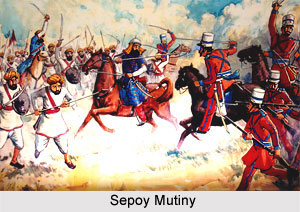 The Wahabi Movement was a part of the Indian freedom struggle as it offered a serious threat to British supremacy in India in the 19th century. The movement was led by Syed Ahmed Barelvi, who was greatly influenced by the teaching of Abdul Wahab of Arabia and the preaching of Delhi saint Shah Walliullah. The Wahabi Movement essentially condemned all changes and innovations to Islam. It was a revivalist movement which held that the return to the true spirit of Islam was the only way to get rid of the socio- political oppression
The Wahabi Movement was a part of the Indian freedom struggle as it offered a serious threat to British supremacy in India in the 19th century. The movement was led by Syed Ahmed Barelvi, who was greatly influenced by the teaching of Abdul Wahab of Arabia and the preaching of Delhi saint Shah Walliullah. The Wahabi Movement essentially condemned all changes and innovations to Islam. It was a revivalist movement which held that the return to the true spirit of Islam was the only way to get rid of the socio- political oppression
To materialize the desired objectives of the Wahabi Movement, Syed Ahmed looked for the right leader, a proper organization, a safe territory, wherefrom to launch his Jihad. Syed Ahmed was declared as the desired leader or Imam. He built up a countrywide organization with an elaborate secret code. The organization worked under four spiritual associate trustees called Khalifas. The missions of the Wahabis were mainly concentrated in the region of Hyderabad, Chennai, Bengal, Uttar Pradesh and Mumbai. The Wahabis played diplomatically with the solemn aim to establish their supremacy. With this intent in mind, the Wahabis first launched a Jihad against the Sikh kingdom in Punjab. In 1830 they occupied Peshawar. But in the following year Syed Ahmed lost his life in his fighting against the Sikhs. After the overthrow of the Sikh ruler and the incorporation of Punjab into the dominion of the British East India Company, the sole target of the Wahabis` attack was the English dominion in India. Wilayat Ali and Enayat Ali, the two brothers of the Sadiquepur family of Patna, had come into contact with Syed Ahmed and became his disciples. After the death of Syed Ahmed in May 1831, they kept on working alternatively in faraway places like Sitana in the west and Frontier Rajmahal, Malda and Chittagong in east Bengal and carried on their revolutionary activities to end British domination in India. They were the pioneers in perfecting the system of despatch of men and money from India which continued with wonderful efficiency and fool-proof accuracy for a long time. In 1847, the Wahabis started full preparation for an absolute war against the British rule in India from their base camp in Sitana. Wilayet Ali became the undisputed leader.
The British took up brutal measures and the period between 1863-65, witnessed a series of trials by which all the principal leaders of the Wahabi movement were arrested. The Ambala trial of 1864 and Patna trial of 1865 were closely interlinked. Yahaya Ali along with Mohammed Jafar and Mohammed Shaft was sentenced to death in the Ambala trial and the others were sentenced to expatriation for life. The death sentences were later converted to transportation for life. Yahaya Ali was sent to the Andamans to undergo his sentence for life imprisonment. Ahmadullah was convicted in the Patna trial (1865) along with Fayzeli, Yahaya Ali and Farhat Ali. He was convicted for devising a conspiracy and initiating an orchestrated treason. The death sentence of Ahmadullah awarded on 27th February 1865 was later on converted to deportation for life by the high court and he was sent to the Andamans in June 1865. Amiruddin was convicted to life imprisonment in the Malda trial (1870) and was transported to the Andamans and his property was confiscated. The most respected leader of the Wahabi Movement, Ibrahim Mandal of Islampur, was convicted in Raj Mahal trial (1870) for organising movement at Raj Shahi and was sentenced to transportation for life and was send off to the Andamans. He was, however, released in 1878 by Lord Lytton. Amir Khan and Hashmat Khan sentenced to transportation for life were also sent to the Andamans after they were arrested in July 1869 on the charge of raising funds for crusade against the British rulers.
It is therefore evident from the foregoing discussion that the Wahabis were a major part of the Indian freedom movement. During the Sepoy Mutiny of 1857, the Wahabis played a notable role in spreading anti-British sentiments. However historians have opined that though the Wahabis spread anti-British sentiments, they did not have exact participation in anti- British Military activities.






































